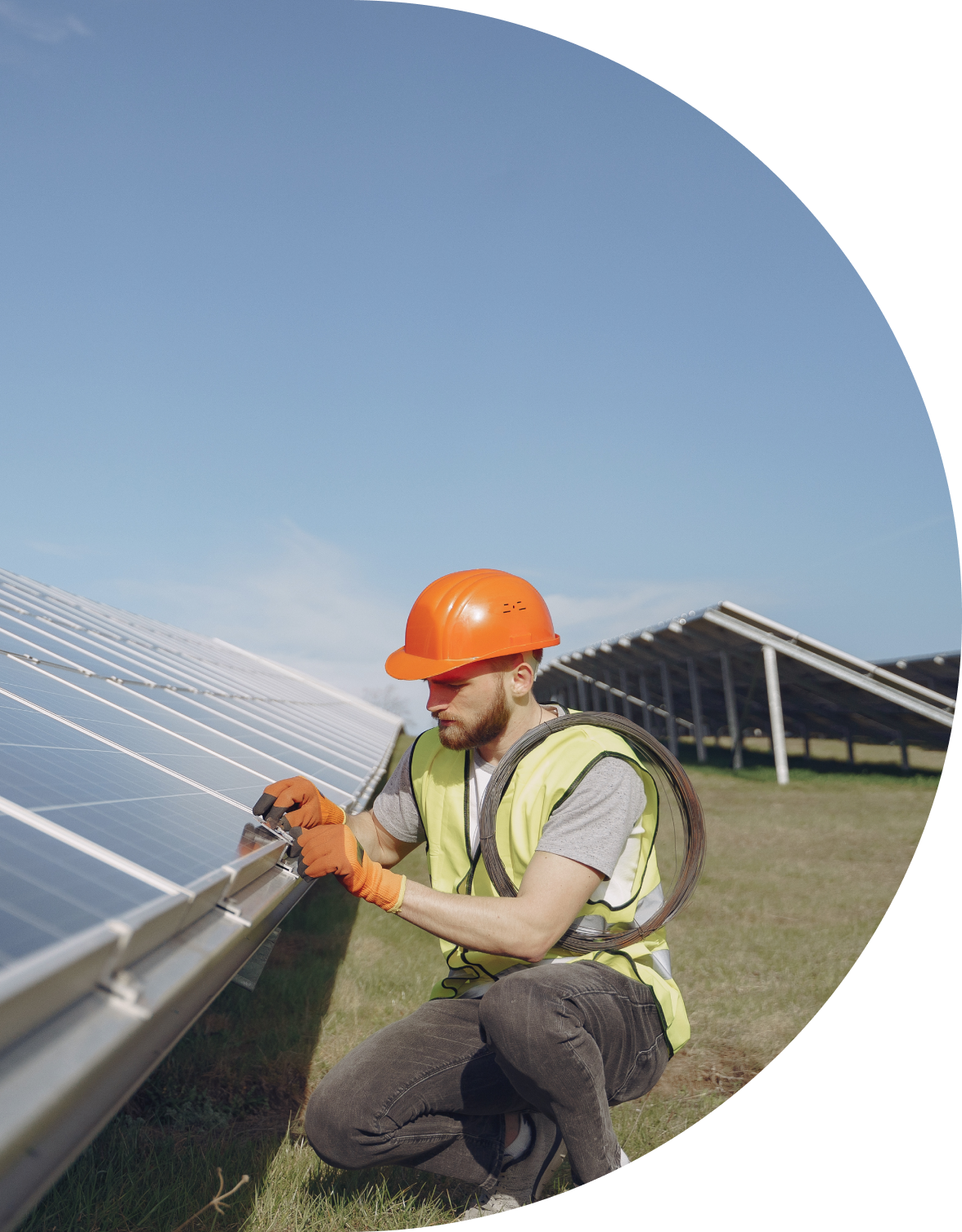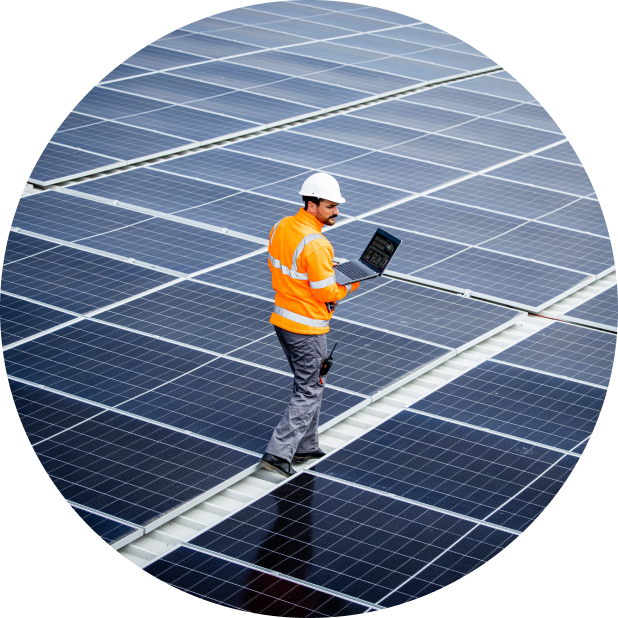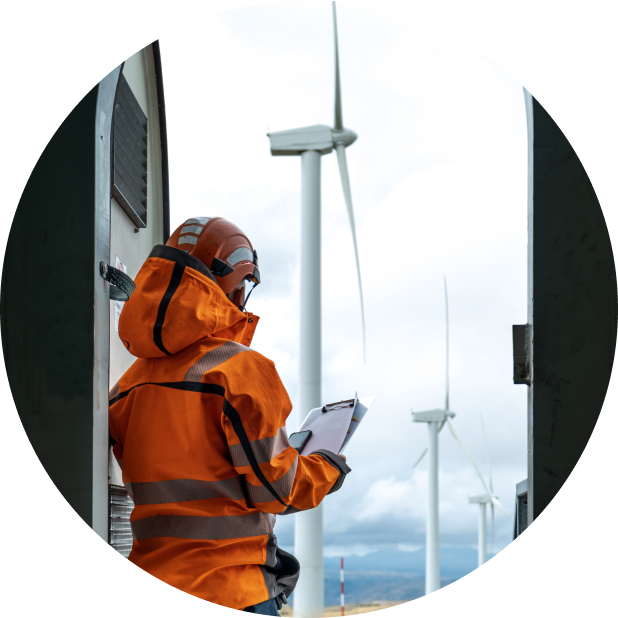TCFD
As the third year of the World Bank Group Climate Change Action Plan (CCAP) (2021-2025) ends, this report is MIGA’s third disclosure under the guidelines recommended by the Task Force on Climate-related Financial Disclosures (TCFD). MIGA’s climate action efforts and the impacts of its guarantees on the global goals of climate change mitigation and adaptation continue to evolve and strengthen, and collectively the World Bank Group remains the largest financier of climate action among the Multilateral Development Banks (MDBs) for low to middle-income countries.
Read MoreMobilizing private sector financing at scale is critical for low-carbon and climate-resilient development in MIGA’s client countries. Over the past year, MIGA has enabled private sector mobilization for critical climate action needs, including through: expanding access to low-carbon electricity; building climate resilient infrastructure; developing low-carbon transportation modes; promoting climate smart agriculture; boosting investments in greening initiatives to improve resource efficiencies; lowering the operational greenhouse gas (GHG) footprint of manufacturing; and supporting financial institutions grow their climate finance lending.
In addition, MIGA, as part of the World Bank Group, continues to play an important role in the development of the Country Climate and Development Reports (CCDRs), which integrate climate change with development and define priority actions for the World Bank Group’s client countries to support a low-carbon and climate-resilient transition. These diagnostics describe transition and physical climate-related risks, policy interventions, public resource constraints, and private sector financing gaps and barriers. MIGA is ensuring its support for climate action continues to be aligned with broader strategies for green, resilient and inclusive development in MIGA’s client countries. This report highlights updates to MIGA’s climate change strategy, as well as internal procedures for climate change management and climate action results for FY23. Notably, FY23 also marks the end of MIGA’s core strategy document, the Strategy and Business Outlook (FY21-23), and FY24 will see the actioning of MIGA’s new Strategy and Business Outlook (FY24-26).
As the World Bank Group is undergoing an “Evolution” to better address the global challenges to development, including climate change, MIGA is strengthening its commitment to the threats posed by global warming in both low and middle-income countries. Ongoing discussions continue to highlight MIGA’s role in private capital mobilization and the power of guarantees to de-risk private finance and investment for scaling and replicating climate action.
Additionally, as of July 1, 2023 (FY24), MIGA’s commitment to align 85 percent of its new projects with the goals of the Paris Agreement will also be actioned, and this will be followed by aligning 100 percent of MIGA’s projects from July 1, 2025 (FY26). Paris alignment requires financing for development to be consistent with low-carbon and climate-resilient pathways to limit global warming to well below 2 degrees Celsius, and preferably 1.5 degrees Celsius, above pre-industrial levels. To prepare for this, in FY23, MIGA undertook an extensive review of its business and resources and developed an implementation plan, including developing training and guidance materials, hiring subject matter experts, focusing on product innovations, and strengthening its partnerships. This report reflects MIGA’s continued commitment to disclose its climate action results following the TCFD’s recommendations and is organized around four core elements (see Figure 1).
Figure 1 Core Elements of the TCFD frameworkGovernance
The organization's governance around climate-related risks and opportunities.

Strategy
The actual and potential impacts of climate-related risks and opportunities on the organization's businesses, strategy, and financial planning

Risk Management
The process used by the organization to identify, assess, and manage climate-related risks

Metrics & Targets
The metrics and targets used to assess and manage relevant climate-related risks and opportunities
All aspects of MIGA’s climate business and related protocols are overseen by MIGA’s Executive Vice President (EVP), who reports to the President of the World Bank Group.The World Bank Group President sets the overall ambition on climate action for the World Bank Group and is selected by the Executive Directors of the Boards of IBRD, IDA, IFC and MIGA. (While there are four Boards, Executive Directors serving on these Boards are usually the same). MIGA’s Board of Directors, comprising 25 representatives from MIGA’s member countries, are responsible for approving all of MIGA’s operations and policies. Notably, FY24 will see the actioning of MIGA’s commitment to its Board of Directors to align 85 percent of its new guarantees with the low-carbon and climate-resilient goals of the Paris Agreement. The Board of Directors also endorsed the CCAP and a World Bank Group climate finance target of 35 percent of MIGA’s guarantee issuance to be comprised of climate mitigation or climate adaptation finance, on average, over the period 2021 to 2025. MIGA management reports its progress to MIGA’s Board of Directors as part of periodic reports from the EVP. MIGA, on an annual basis, also reports on its implementation results of the CCAP to the World Bank Group Board of Directors.
Read MoreVice Presidential Leadership
Under the responsibility of MIGA’s EVP are two Vice Presidents. MIGA’s Vice Presidents participate in various World Bank Group formal and informal groups that review and approve major World Bank Group initiatives, strategies, policies and targets—including those pertaining to climate—before submission to the Board of Directors.
The Vice President, Operations, oversees two Operations departments: (a) Infrastructure, Manufacturing, Agribusiness, Services and Trade Operations; and (b) Energy, Extractives, Capital and Financial Markets. Both departments are mandated to identify climate business opportunities, develop new MIGA products and innovate existing MIGA product applications to mobilize more private capital for low-carbon and climate-resilient development.
The Vice President, Chief Risk, Legal & Sustainability Officer and Partnerships oversees three MIGA departments: (a) Finance and Risk Management, (b) Economics and Sustainability, and (c) Legal Affairs and Claims. The Director of Economics and Sustainability oversees, among other responsibilities, the Sustainability and Climate units, which work with MIGA’s operations management and staff, as well as clients, to address environmental and social risks, and transition and physical climate-related risks, in all MIGA’s operations.
The Climate unit includes a team of climate change specialists who are responsible for climate analytics as well as the climate- related policy, innovation and partnership work program. Among the unit’s responsibilities are: climate finance accounting; Paris alignment assessment; GHG emissions accounting; support of the development of climate-related internal and/or external frameworks; policies and guidance materials on salient climate-related thematic areas; development of new MIGA products to foster low-carbon and climate-resilient investments; analysis and reporting on MIGA’s climate business; monitoring of MIGA’s portfolio of projects to ensure climate action commitments made at the project approval stage by MIGA’s clients are being adhered to; contributing to World Bank Group climate analytics and strategic initiatives; and participating in joint MDB working groups on climate finance and Paris alignment. To assist with the mainstreaming of Paris alignment methodologies, staff in this unit also provide sector-specific training to colleagues in the Operations department.
Strategy, Policy and Project Review Process
MIGA’s strategies, policies and projects are overseen by the MIGA Management Team (MMT), which includes MIGA’s Directors, Vice Presidents, and EVP.
The MMT reviews the processes and procedures for all projects to be supported by MIGA (see Figure 2). There are two stages of project review: the Early Screening Committee (ESC) where the MIGA project team presents a preliminary evaluation of the project, including if the project is aligned with MIGA’s mandate and business strategy and policies; and the Project Review Committee (PRC) where a full evaluation of the project is presented, including any contractual requirements that must be adopted to ensure the project will be aligned with MIGA’s climate commitments, MIGA’s Policy on Environmental and Social Sustainability and MIGA’s Environmental and Social Performance Standards. If a project is approved at PRC, it will then proceed for approval to MIGA’s Board of Directors, under the delegated authority from the World Bank Group President to MIGA’s EVP.
All individual projects supported by MIGA are either approved by the Board of Directors directly or under specific authority delegated by the Board to MIGA’s management. MIGA’s Board of Directors can seek clarification from MIGA management on MIGA projects submitted for approval, including on climate risks and resilience requirements, opportunities to maximize climate finance by enhancing the climate mitigation or climate adaptation benefits, and the project’s alignment with the goals of the Paris Agreement.

Climate action requires substantial private capital, and MIGA’s political risk insurance and credit enhancement products continue to play an instrumental role in mobilizing and directing cross-border investments to lower GHG alternatives that are also climate resilient. Private investors deploying capital into low- and middle-income countries are faced with multiple challenges, including non-commercial risks and a dearth of bankable high quality climate projects and non-commercial risks.
Working alongside the World Bank and IFC, MIGA supports its eligible member countries in defining implementation plans and project pipelines that are aligned with their national climate change commitments. To complement this, as the “rulebook” of the Paris Agreement continues to be defined, MIGA is actively innovating the application of its guarantees to meet the needs of investors looking to participate in new climate markets, for example, in carbon markets established under Article 6 of the Paris Agreement.
MIGA also recognizes that financial institutions play a critical role in building economies, but that the performance of these institutions will be challenged by climate change, and, in particular, for those institutions with balance sheets heavily exposed to transition or physical climate-related risks. As such, MIGA’s operations continue to focus on mobilizing climate finance through financial institutions which commit to use MIGA guaranteed funds or capital optimization guarantees to grow their climate finance loan books and move away from investments in coal and other non-Paris aligned activities.
To address non-commercial risks, MIGA provides political risk insurance and credit enhancement guarantees, both of which boost investor confidence in the safety of investments and encourage the flow of foreign investment for sustainable purposes. As a member of the World Bank Group, MIGA is well placed to resolve potential disagreements between the private sector and government and deter actions that could disrupt guaranteed investments. This role is critical for the materialization of the long-term gains of climate change mitigation and adaptation investments.
In FY23, MIGA issued guarantees in support of debt and equity investments of around $5.5 billion of which $1.53 billion supported climate change mitigation or adaptation in 23 countries across four regions, representing 27.7 percent of guaranteed investment in FY23.
- MIGA’s total gross Issuance in FY23 was $6.4 billion of which around $5.5 billion represented underlying loan and equity investments guaranteed. The difference between the $6.4 billion and the $5.5 billion represents guaranteed amounts pertaining to financing for other costs than the underlying investments (e.g., future interest payments, financing of premium payments). Beginning in FY22, MIGA’s climate finance target is computed as a percentage of the underlying loan and equity investments guaranteed instead of the total gross guarantee issuance.

The World Bank Group CCAP aims to integrate climate with development and advance the World Bank Group’s Green, Resilient and Inclusive Development objectives by focusing on people, natural capital and partners. The CCAP reflects the World Bank Group’s ambition to support its public and private sector clients to maximize the impact of climate finance, aiming for measurable improvements in climate adaptation and resilience and reductions in GHG emissions. The CCAP objectives include: (i) integrating climate and development; (ii) prioritizing key systems transitions by identifying the largest climate mitigation and adaptation opportunities; and (iii) driving climate finance and leveraging private capital to deliver the maximum results.
Addressing climate change is a priority area for MIGA, along with support for low-income countries and countries facing fragility, conflict and violence. MIGA’s climate strategy reflects the ambition of the commitments made in the CCAP, MIGA’s Strategy and Business Outlook (FY21–23) and MIGA’s Strategy and Business Outlook (FY24-26) to deepen its impact. MIGA’s commitments under the CCAP include:
- Increasing the share of MIGA guarantees toward climate mitigation and adaptation to an average of 35 percent of MIGA’s overall business during the 2021 to 2025 period;
- Working with the World Bank and IFC to produce the World Bank Group’s own dedicated country climate and development diagnostics, the CCDRs. These diagnostics will help countries align their climate action and development agendas by capturing key mechanisms by which climate change is affecting economic, environmental and social support systems. The Reports aim to identify the main pathways and priority actions to reduce GHG emissions and climate vulnerabilities;
- Mobilizing more private capital toward climate action through innovative applications of MIGA’s political risk insurance and credit enhancement products in high climate-impact sectors;
- Aligning MIGA’s financial flows with the low-carbon and climate-resilient objectives of the Paris Agreement by (i) ensuring that 85 percent of new Board-approved operations are aligned with the goals of the Paris Agreement starting July 1, 2023, and 100 percent starting July 1, 2025 (which has required beginning to align 100 percent of MIGA’s projects at an early stage, well ahead of July 1, 2023). These timelines apply to both MIGA’s real sector guarantee projects and financial intermediary guarantee projects; and
- Boosting private sector investment that integrates climate risk management measures and supports adaptation and resilience by screening all proposed MIGA guarantees for physical climate risks.
To assist clients, MIGA also administers multiple trust funds including two trust funds established in FY22:
- the Renewable Energy Catalyst Trust Fund, which is designed to support renewable energy projects, providing solutions such as a first-loss layers, reinsurance, direct technical assistance or grants to facilitate project development; and
- the Fund for Advancing Sustainability Trust Fund, which aims to enhance the sustainable development impacts of MIGA projects and mitigate their risks by delivering direct technical assistance through third-party service providers, and through technical assistance grants.
Prioritizing Key Systems Transitions
During FY23, MIGA focused on six strategic areas for its climate business: clean energy, climate-resilient infrastructure, green buildings, low-carbon transportation, climate-smart agriculture, and greening financial systems. Support for these sectors is critical to ensure MIGA’s client countries align their development with low-carbon and climate-resilient pathways. To ensure intended development objectives are achieved and gains are sustained, MIGA evaluates the materiality of both physical and transition climate-related risks for all sectors and aims to define appropriate risk mitigation measures where necessary.

Clean Energy
The energy sector is the largest contributor to global GHG emissions, and MIGA is supporting countries in decarbonizing their energy sectors by mobilizing private sector financing for utility-scale renewable power generation; off-grid, mini-grid and microgrid co-generation with battery energy storage systems; modernization and expansion of transmission and distribution infrastructure; decommissioning and replacement of inefficient carbon intensive power generation; demand-side management; and power system planning.
In FY23, the World Bank Group announced an innovative initiative to accelerate electrification in Africa, the Distributed Access through Renewable Energy Scale-Up Platform (DARES). DARES is designed to promote private investments in distributed renewable energy systems with a focus on mini-grids, off-grid solar markets, solar systems for schools and health facilities, and solar irrigation. Through DARES, MIGA continues to deploy its de-risking instruments to attract private capital to assist Africa with achieving universal access to electricity by 2030. MIGA, in collaboration with the World Bank and IFC, is also working with its clients to support the phase out of coal, including through innovative financing and applications of its de-risking and credit enhancement instruments. The transition away from coal must be done justly, with due attention to people in coal-producing regions and related livelihood effects. The World Bank Group stopped direct financing of new utility-scale coal-fired power projects in 2013, and as of 2019 the World Bank Group does not support upstream oil and natural gas.
In specific cases, natural gas-based power generation may be useful in accelerating the transition away from coal by improving power supply reliability and grid stability, allowing for higher penetration of utility-scale renewable power generation. However, MIGA only supports these investments if they are consistent with national climate change commitments and strategies, a decarbonization pathway, and do not result in carbon lock-in or stranded assets.

Climate-resilient infrastructure
Infrastructure is critical for economic growth and development, but as these assets are stationary and intended to operate over a long-life span, climate change is expected to disrupt critical systems, increase operating costs, and potentially accelerate the decommissioning of climate vulnerable components. Over FY23, MIGA has accelerated its focus on defining climate adaptation and resilience building requirements for infrastructure investments. These measures are informed by climate risk assessments which employ localized climate hazard datasets and projections to identify if climate change allowances should be incorporated into the engineering design, and if climate risk management policies, plans and procedures should be included in project operations. For example, for coastal infrastructure projects such as ports, MIGA assess both acute and chronic climate hazards such as coastal storm surge, tropical cyclones, and sea-level rise.
Based on projections of climate hazard occurrence and the materiality of expected impacts, MIGA works with its clients to determine the costs of inaction and the benefits of investments in climate adaptation and resilience building measures. Notably, for infrastructure investments, business as usual design considerations to mitigate climate hazards which do not incorporate climate change are not considered to be climate resilient. For example, a motorway with road drainage that does not factor changes in precipitation and flood occurrence as a result of climate change, is not considered to be climate resilient road drainage. Over the last fiscal year, the share of infrastructure projects with climate adaptation and resilience-building components has increased significantly. This is a result of MIGA’s increased engagement with project engineers and lenders to direct MIGA guarantees to specific, measurable, structural, and non-structural resilience building interventions.

Green Buildings
MIGA continues to grow its green-building business, both through de-risking project finance for asset owners in the healthcare and tourism sectors and by supporting financial intermediaries who are developing financial instruments such as green mortgages or loan programs for energy efficiency improvements in small to medium-sized enterprises. In FY23, the results of MIGA’s political risk guarantees in support of greening interventions were demonstrated by a large real estate private equity platform in Sub-Saharan Africa. This fund acquires, rehabilitates and achieves green building certification for assets in the hospitality sector across ten countries. To date, MIGA has supported the acquisition and rehabilitation of 13 hotels, eight of which have been certified as green buildings, with the remaining buildings currently undergoing evaluations. Of the eight certified hotels, six have reported to MIGA that, as a result of achieving green building certification, average energy and water savings of 917 MWh/year and 6,257 m3/year are expected, leading to a total reduction of over 2,500 tons of CO2e/year for the six hotels.
MIGA is also working with municipalities on expanding and protecting green urban areas; building community spaces to enhance neighborhoods; improving solid waste and wastewater treatment; rehabilitating stormwater drainage systems; expanding healthcare infrastructure; and installing energy efficient street lighting.

Low-carbon Transport
The movement of goods and people is central to sustaining economic development, yet transportation systems are a significant source of GHG emissions and operate over large footprints, complicating climate resilience efforts. Following the World Bank, MIGA has adopted the "Avoid-Shift-Improve+Resilience" (ASI+R) approach for decarbonizing transportation systems. Specifically, this approach calls for: avoiding carbon intensive transportation modes ("A") by providing alternatives; shifting transportation modes to mass transport, non-motorized and multi-modal options ("S"); improving transportation-related emissions through the deployment of electric mobility, rapid bus transit, and effective traffic management ("I"); and investing in resilience building to limit the impacts of climate change on the performance of transportation systems ("R"). In actioning this approach over FY23, MIGA has issued guarantees in support of electric mobility, fleets and supporting infrastructure; ports; and rehabilitation projects for rural and peri-urban roads. All transportation investments in greenfield road projects are checked to ensure they align with low-carbon transportation strategies, and that any fossil-fuel-intensive transportation systems do not delay or prevent the transition to lower-carbon alternatives.

Climate-smart agriculture
The agricultural sector is among the most sensitive to climate change, and MIGA is increasing its support for climate-smart agriculture to enhance productivity, reduce GHG emissions and improve climate resilience. By de-risking cross-border investments for agriculture, MIGA is tackling food insecurity by also encouraging technology and skills transfers to boost local practices. In addition, by focusing along the entire agricultural value chain, MIGA is aiming to augment resource efficiency, increase productivity and net returns, reduce food insecurity, and improve gender inclusion. In FY23, MIGA continued to provide support for critical climate-smart agricultural projects in the world’s poorest and most fragile countries. These projects employ innovative practices to boost resource efficiency while increasing productivity beyond normal farming practices.

Greening Financial institutions
MIGA is also prioritizing the use of its guarantee products to support the greening of financial institutions, with a focus on promoting climate-friendly, sustainable financing practices. MIGA’s engagement with financial institution clients is serving to channel the use of proceeds of MIGA-supported finance—or the capital relief facilitated by MIGA’s capital optimization product—toward climate adaptation and mitigation investments. For example, in FY23, MIGA guarantees enabled commitments by financial institutions to deliver over $700 million towards climate finance. In addition, MIGA no longer supports financial institution clients that do not have a plan to phase out their investments in coal and coal-related projects over an agreed period, but no later than 2030.
In working with its financial institution clients in FY24 on aligning their operations with the goals of the Paris Agreement, MIGA is adopting two approaches consistent with the Joint MDB Methodological Principles for Assessment of Paris Agreement Alignment pertaining to Intermediated Finance: (i) a transaction-based approach that aims to ensure that the defined use of proceeds supported by the MIGA guarantee are consistent with low-carbon and climate-resilient development; and (ii) a counter-party-based approach when the use of proceeds is not defined, in which case MIGA will require its financial institution clients to develop and implement internal carbon and climate-risk management systems and gradually increase their exposure to Paris-aligned activities.
Read Less
In assessing the materiality of climate change risks, MIGA works with its clients to evaluate climate risk sources and risk vectors for climate sensitive sectors (see Table 1). MIGA adopts a bottom-up approach, which is location-, context- and time-specific, and focuses on past, present and future climate-related vulnerabilities. The assessments include both acute climate hazards (e.g., extreme events such as floods, heatwaves, fires, and tropical cyclones) and chronic climate hazards (e.g., sea-level rise, changing precipitation and temperature patterns, and water scarcity) that are evaluated over multiple future time horizons and global warming scenarios. In defining risk mitigation measures, MIGA’s approach is centered on helping clients:
- Evaluate and characterize the materiality of expected climate impacts;
- Identify the costs and benefits of action and inaction;
- Define structural and non-structural improvements, including through factoring "climate change allowances" into relevant design criteria; and
- Implement risk monitoring through technologies, operational procedures, and policies.
Table 1
Climate Change Risks: Renewable Energy risk sources and risk vectors
| Sector | Sub-Sector | Risk Sources | Risk Vectors |
|---|---|---|---|
| Energy | Re Generation (Solar) | Temperature, Precipitation, Wind |
|
| Re Generation (Wind) | Temperature, Wind |
|
|
| Re Generation (Hydro) | Precipitation, Wind |
|
|
| Transmission and Distribution | Temperature, Wind |
|
MIGA also recognizes that increased losses and damages from frequent and severe extreme weather events, and the rapid political and legal changes that are fostering the transition to low-carbon development could also exacerbate political economy and legal and governance risks in MIGA’s client countries (see Table 2). While the relationships may be imprecise and non-linear, climate impacts will depend on a confluence of economic factors (e.g., per capita income, sovereign debt levels, GDP growth potential, fiscal revenues as a percent of GDP, the quality of infrastructure, and the level of economic diversification) and political economy and governance factors (e.g., adherence to the rule of law, the strength of political institutions, regulatory frameworks, and climate policies).
Under the requirements of Performance Standard 3, Resource Efficiency and Pollution Prevention, all projects that are expected to generate more than 25,000 tons of carbon dioxide equivalent (tCO2e) annually must quantify and report to MIGA: (i) the direct emissions from the facilities owned or controlled within the physical boundary of the project; and (ii) the indirect emissions associated with the off-site production of power used by the project.
MIGA’s contracts of guarantee increasingly are including climate-related action plans for projects where gaps have been identified during the project’s due diligence. Monitoring requirements are also included, and MIGA’s clients must submit Annual Monitoring Reports and status reports on the corrective action plans. In addition, MIGA staff may conduct periodic site monitoring visits to ensure compliance.
By aligning its operations with the goals of the Paris Agreement, MIGA seeks to support clients in ways that are consistent with a country’s Nationally Determined Contributions, national long-term strategies and other climate commitments. MIGA applies the Joint MDB Methodological Principles for Assessment of Paris Agreement Alignment to determine if MIGA’s operations are aligned with low-carbon and climate-resilient pathways.
The principles include a list of operations which are considered universally aligned with the low-carbon goals of the Paris Agreement. These operations are considered to contribute directly to decarbonization pathways or are neutral to or do not hinder low-carbon growth. This list includes a broad range of sectors and asset types, such as renewable energy generation, transmission and distribution infrastructure, electric mobility and water supply infrastructure. However, operations that are included on the universally aligned list, but whose economic feasibility depends on fossil fuels, are required to undergo a more detailed assessment. This assessment is also applied to non-universally aligned operations and requires that operations are checked to ensure they are not inconsistent with a country’s Nationally Determined Contributions, national long-term strategies, and sector-specific Paris alignment criteria; will not prevent opportunities to transition; or result in carbon lock-in, stranded assets or other transition risks.
Table 2
Climate Change Risks: Impact on non-commercial risks
| Risk Sources | Risk Vectors | Non-commercial risks |
|---|---|---|
|
Physical risks  |
|
|
|
Transition risks  |
|
|
Aligning an operation with the adaptation and resilience goals of the Paris Agreement, entails conducting a climate risk assessment and working with clients to embed measures that manage material physical climate risks that may impact the project’s performance. Operations are also assessed to ensure they are aligned with the respective countries’ national adaptation plans or policies on climate resilience, while not contributing to maladaptation.
MIGA will assess operations for Paris Alignment in the broader context of the World Bank Group’s mission of ending extreme poverty and boosting shared prosperity on a livable planet. This entails considering, among other things, equity concerns and the principle of common but differentiated responsibilities and respective capabilities, given countries’ differing national circumstances. MIGA has also started piloting a shadow carbon price to further address transition risks in its economic analysis of carbon-intensive projects.
To support low-carbon and resilient development across sectors, MIGA continues to diversify its climate business and identify new areas of growth. Under the World Bank Group’s CCAP, 35 percent of MIGA’s gross issuance will consist of direct climate finance over the five-year period of 2021–25, on average. In addition, MIGA has made commitments for projects to be aligned with the low-carbon and climate-resilient development goals of the Paris Agreement. MIGA will align 85 percent of new operations starting July 1, 2023, and 100 percent of MIGA’s new operations by July 1, 2025.
In FY23, climate finance accounted for 27.7 percent of MIGA’s total guarantee investments (see Figure 3). By regional breakdown, the largest share of this issuance was provided to Latin America and the Caribbean followed by Sub-Saharan Africa (see Figure 4). However, these results show that MIGA’s climate finance issuance supports low-carbon and climate-resilient projects across the regions where the World Bank Group operates, with little concentration in any particular region or sector. Exposures to the various sectors during FY21-FY23 show that climate financing through financial intermediaries (which support activities across sectors) is the largest sectoral exposure, at 41 percent, followed by green buildings at 25 percent and renewable energy at 23 percent (see Figure 5).
Figure 3
MIGA’s climate finance issuance FY 21-23 (dollar value and as a percent of loan and equity investments guaranteed)

Figure 4
MIGA’s climate finance issuance by region

Figure 5
MIGA Climate Finance Issuance by Sector

Highlights of MIGA-supported projects’ anticipated outcomes and results include:



MIGA has developed an internal Impact Performance Assessment and Comparison Tool (IMPACT), which is used to assess, and rate expected project-specific outcomes (including those related to climate outcomes), as well as “beyond-the-project” outcomes that provide positive demonstration effects to cross-border investors (including those pertaining to environment and climate). Before approval, all projects are assessed and rated in line with the IMPACT process for expected development outcomes. Projects that support expected positive climate outcomes are expected to deliver better development outcomes and receive higher scores than equivalent projects without these benefits.
MIGA continues to calculate and report GHG emissions avoided (tCO2e/year) and GHG gross emissions (“Scope 1 and 2”). MIGA calculates gross GHG emissions for all real-sector projects with emissions of more than 25,000 tCO2e annually. MIGA continues to disclose ex ante estimated annual gross GHG emissions through the publicly available Environmental and Social Review Summary available for all MIGA projects.
From FY19 to FY20, MIGA reduced its travel-related carbon footprint from 2,018 tCO2e to 1,414 tCO2e. For FY22 (the most recent data available), MIGA further lowered its travel-related carbon footprint to 489 tCO2e.
- In FY21, MIGA’s travel-related carbon footprint declined to only 20 metric tCO2e owing to the significant reduction in business travel resulting from the COVID-19 pandemic.






